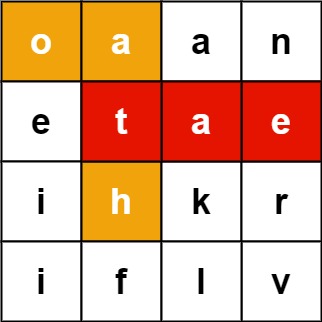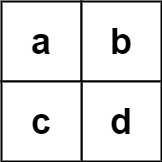A trie (pronounced as "try") or prefix tree is a tree data structure used to efficiently store and retrieve keys in a dataset of strings. There are various applications of this data structure, such as autocomplete and spellchecker.
Implement the Trie class:
Trie()Initializes the trie object.def insert(word: str)Inserts the stringwordinto the trie.def search(word: str) -> boolReturnstrueif the stringwordis in the trie (i.e., was inserted before), andfalseotherwise.def startsWith(prefix: str) -> boolReturnstrueif there is a previously inserted stringwordthat has the prefixprefix, andfalseotherwise.
Example 1:
Input
["Trie", "insert", "search", "search", "startsWith", "insert", "search"]
[[], ["apple"], ["apple"], ["app"], ["app"], ["app"], ["app"]]
Output
[null, null, true, false, true, null, true]
Explanation
Trie trie = new Trie();
trie.insert("apple");
trie.search("apple"); // return True
trie.search("app"); // return False
trie.startsWith("app"); // return True
trie.insert("app");
trie.search("app"); // return Trueobj = Trie()
word1 = 'apple'
obj.insert(word1)
print(obj.search(word1)) # True
word2 = 'app'
print(obj.search(word2)) # False because the word "app" is not present in the Trie object
prefix = 'app'
print(obj.startsWith(prefix)) # True because the previously inserted string `word` has the prefix `prefix`
obj.insert(word2)
print(obj.search(word2)) # True because the word "app" has been inserted in the Trie object
The TrieNode class represents each node in the Trie. Each node contains:
- A dictionary
childrento store the children nodes. - A boolean
endOfWordto indicate if the node marks the end of a word.
The Trie class manages the TrieNode and implements the three methods insert, search, and startsWith.
- Initialization
class Trie:
def __init__(self):
self.root = TrieNode()- Insert Method
The insert method adds a word to the Trie. Starting from the root, it iterates through each character in the word. If a character is not already a child of the current node, it creates a new TrieNode. After processing all characters, it marks the last node's endOfWord as True.
- Search Method
The search method checks if a word is in the Trie. Starting from the root, it iterates through each character in the word. If a character is not found in the current node's children, it returns False. If all characters are found, it returns True only if the last node's endOfWord is True.
- StartsWith Method
The startsWith method checks if there is any word in the Trie that starts with the given prefix. It follows a similar process to the search method but returns True as soon as all characters in the prefix are found.
-
Insert Method:
-
Time Complexity:
$(O(n))$ , where$(n)$ is the length of the word. This is because each character of the word is processed once. -
Space Complexity:
$(O(n))$ in the worst case, where each character in the word requires a newTrieNode.
-
Time Complexity:
-
Search Method:
-
Time Complexity:
$(O(n))$ , where$(n)$ is the length of the word. Each character is checked once. -
Space Complexity:
$(O(1))$ , as no additional space is needed beyond the input word.
-
Time Complexity:
-
StartsWith Method:
-
Time Complexity:
$(O(m))$ , where$(m)$ is the length of the prefix. Each character in the prefix is checked once. -
Space Complexity:
$(O(1))$ , similar to thesearchmethod.
-
Time Complexity:
-
Insertion of "apple":
- Traverse through each character in "apple" and create new
TrieNodefor each character. - Mark the last node (representing 'e') with
endOfWord = True.
- Traverse through each character in "apple" and create new
-
Search for "apple":
- Traverse through each character in "apple".
- Since all characters are found and the last node has
endOfWord = True, returnTrue.
-
Search for "app":
- Traverse through each character in "app".
- The last node (representing 'p') does not have
endOfWord = True, so returnFalse.
-
StartsWith "app":
- Traverse through each character in "app".
- Since all characters are found, return
True.
-
Insertion of "app":
- Traverse through each character in "app" and use existing nodes.
- Mark the last node (representing 'p') with
endOfWord = True.
-
Search for "app" again:
- Traverse through each character in "app".
- Since all characters are found and the last node has
endOfWord = True, returnTrue.
Design a data structure that supports adding new words and finding if a string matches any previously added string.
Implement the WordDictionary class:
WordDictionary()Initializes the object.void addWord(word)Addswordto the data structure, it can be matched later.bool search(word)Returnstrueif there is any string in the data structure that matcheswordorfalseotherwise.wordmay contain dots'.'where dots can be matched with any letter.
Example 1:
Input
["WordDictionary","addWord","addWord","addWord","search","search","search","search"]
[[],["bad"],["dad"],["mad"],["pad"],["bad"],[".ad"],["b.."]]
Output
[null,null,null,null,false,true,true,true]
Explanation
WordDictionary wordDictionary = new WordDictionary();
wordDictionary.addWord("bad");
wordDictionary.addWord("dad");
wordDictionary.addWord("mad");
wordDictionary.search("pad"); // return False
wordDictionary.search("bad"); // return True
wordDictionary.search(".ad"); // return True
wordDictionary.search("b.."); // return Trueobj = WordDictionary()
word1 = 'bad'
word2 = 'dad'
word3 = 'mad'
obj.addWord(word1)
obj.addWord(word2)
obj.addWord(word3)
print(obj.search("pad")) # False because "pad" is not present in the Trie object
print(obj.search(".ad")) # True because ".ad" matches "bad", "dad", or "mad"
print(obj.search("b..")) # True because "b.." matches "bad"
The TrieNode class represents each node in the Trie. Each node contains:
- A dictionary
childrento store the children nodes. - A boolean
endOfWordto indicate if the node marks the end of a word.
The WordDictionary class manages the TrieNode and implements the methods addWord and search.
- Initialization
class WordDictionary:
def __init__(self):
self.root = TrieNode()- AddWord Method
The addWord method adds a word to the Trie. Starting from the root, it iterates through each character in the word. If a character is not already a child of the current node, it creates a new TrieNode. After processing all characters, it marks the last node's endOfWord as True.
- Search Method
The search method checks if a word is in the Trie. It uses a Depth-First Search (DFS) to handle the dots '.'.
The dfs function is a helper function for recursive DFS:
- It takes the current index
jand the current noderoot. - For each character in the word starting from
j:- If the character is a dot
'.', it recursively checks all children nodes. - If the character is not a dot, it checks if the character exists in the current node's children.
- If the character is a dot
- The function returns
Trueif it successfully matches all characters and the last node marks the end of a word.
-
AddWord Method:
-
Time Complexity:
$(O(n))$ , where$(n)$ is the length of the word. Each character of the word is processed once. -
Space Complexity:
$(O(n))$ in the worst case, where each character in the word requires a newTrieNode.
-
Time Complexity:
-
Search Method:
-
Time Complexity: In the worst case, it can be
$(O(m \times 26^m))$ , where$(m)$ is the length of the word. This is because for each dot'.', it may need to check all possible 26 child nodes, resulting in a combinatorial explosion. -
Space Complexity:
$(O(m))$ for the recursion stack in the worst case where$(m)$ is the length of the word.
-
Time Complexity: In the worst case, it can be
Given an m x n board of characters and a list of strings words, return all words on the board.
Each word must be constructed from letters of sequentially adjacent cells, where adjacent cells are horizontally or vertically neighboring. The same letter cell may not be used more than once in a word.
Example 1:
Input: board = [["o","a","a","n"],["e","t","a","e"],["i","h","k","r"],["i","f","l","v"]], words = ["oath","pea","eat","rain"]
Output: ["eat","oath"]Example 2:
Input: board = [["a","b"],["c","d"]], words = ["abcb"]
Output: []obj = Solution()
board1 = [["o","a","a","n"],["e","t","a","e"],["i","h","k","r"],["i","f","l","v"]]
words1 = ["oath","pea","eat","rain"]
res1 = obj.findWords(board=board1, words=words1)
print(res1)
board2 = [["a","b"],["c","d"]]
word2 = ["abcb"]
res2 = obj.findWords(board=board2, words=word2)
print(res2)
To solve this problem, we utilize a combination of a Trie (prefix tree) and Depth-First Search (DFS). The Trie helps efficiently check if the prefixes of the words are present while performing the DFS.
The TrieNode class represents each node in the Trie. Each node contains:
- A dictionary
childrento store the children nodes. - A boolean
endOfWordto indicate if the node marks the end of a word. - An integer
refsto keep track of the number of references to this node, which helps with optimization during word removal.
The Solution class manages the Trie and implements the findWords method to find all valid words on the board.
- Initialization
The Solution class initializes the root of the Trie.
class Solution:
def __init__(self) -> None:
self.root = TrieNode()- FindWords Method
The findWords method populates the Trie with the given words and uses DFS to find all valid words on the board.
- Adding Words to Trie
def findWords(self, board: list[list[str]], words: list[str]) -> list[str]:
root = self.root
for w in words:
root.addWord(w)- DFS Method
The dfs function performs the Depth-First Search on the board to find all valid words. It:
-
Checks boundary conditions and if the current cell has already been visited or is not in the Trie.
-
Adds the cell to the visited set.
-
Checks if the current node marks the end of a word. If yes, it adds the word to the result set and removes it from the Trie.
-
Recursively explores all four possible directions (up, down, left, right).
-
Removes the cell from the visited set.
-
Iterate Through Board
Finally, the method iterates through each cell in the board and initiates a DFS from that cell.
-
Adding Words to Trie
-
Time Complexity:
$(O(N \cdot M))$ , where$(N)$ is the number of words and$(M)$ is the maximum length of a word. Each character of each word is processed once. -
Space Complexity:
$(O(N \cdot M))$ , where$(N)$ is the number of words and$(M)$ is the maximum length of a word. This is the space required to store the Trie.
-
Time Complexity:
-
DFS Search
-
Time Complexity:
$(O(m \cdot n \cdot 4^L))$ , where$(m)$ and$(n)$ are the dimensions of the board and$(L)$ is the maximum length of a word. Each cell initiates a DFS that explores all possible directions. -
Space Complexity:
$(O(L))$ , where$(L)$ is the maximum length of a word. This is the space required for the recursion stack during DFS.
-
Time Complexity:

